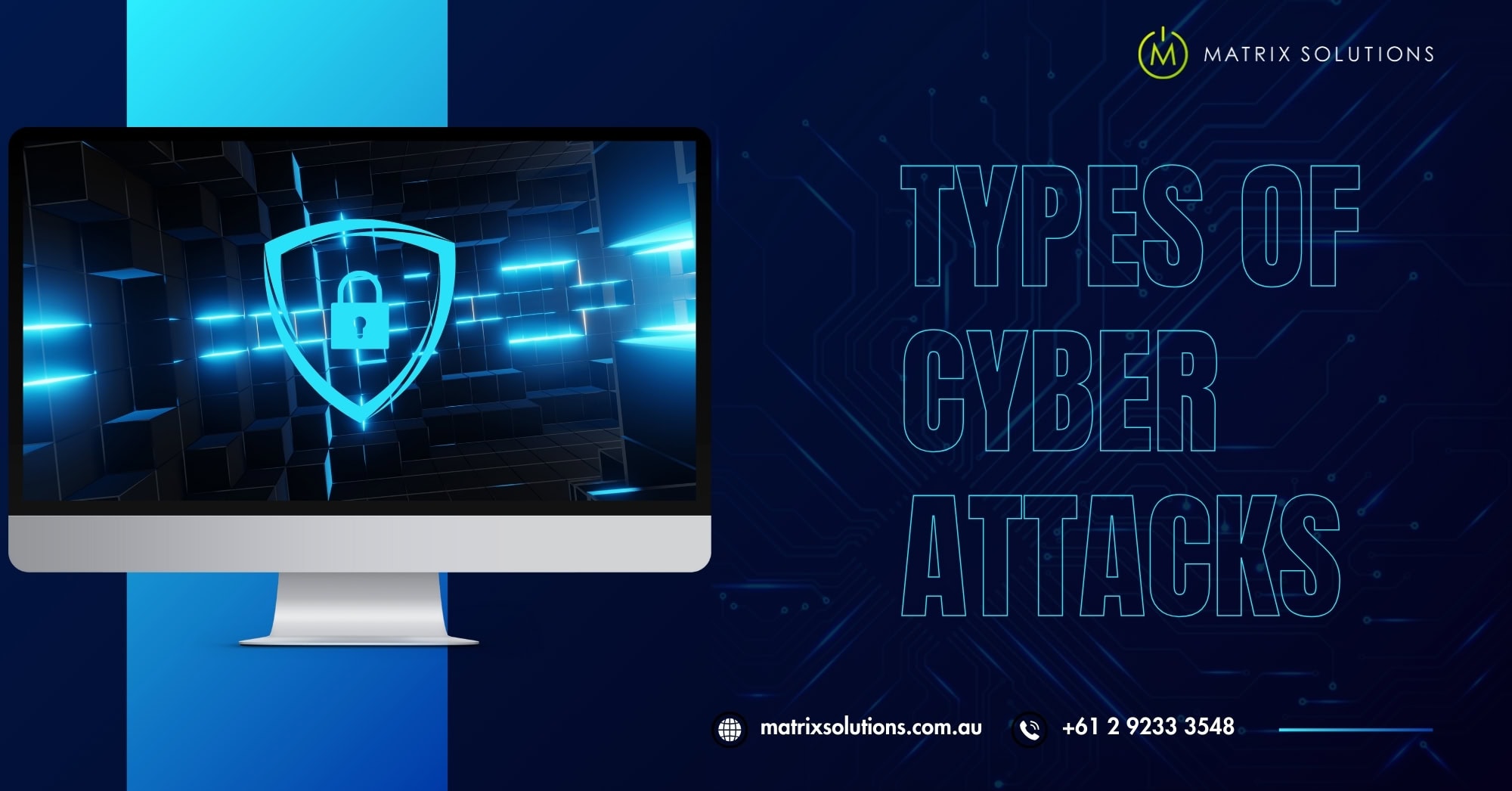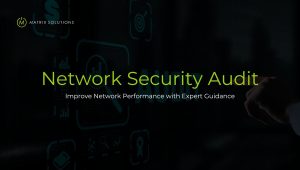Cyber attacks are a growing threat, impacting everyone, from individuals to global enterprises. The good news is that knowledge is your first line of defence. By understanding the various types of cyber attacks, you can better protect your valuable data and digital identity.
In this article, we will demystify the 11 most common types of cyber-attacks Australian businesses face. We’ll break down the technical jargon, making it easy to understand how these attacks work and, more importantly, how to defend against them.
What are Cyber Attacks and Cyber Security?
Cyber attacks are malicious attempts to compromise information systems, typically to steal data, disrupt operations, or cause damage. They can target anyone from individuals to large organisations and take various forms such as phishing, malware, and ransomware.
To answer the question, “What is cyber security?” it involves practices and technologies designed to protect computers, networks, and data from these attacks. Cyber security includes measures like firewalls, antivirus software, and employee training. These safeguards help ensure the integrity, confidentiality, and availability of information.
Understanding the difference between these two terms is crucial. Cyber attacks are the threat, and cyber security is the solution. And as we know more about cyber attacks, you’ll see just how important it is to be prepared and informed.
11 Most Common Types of Cyber Attacks
The most common cyber attacks target digital networks and devices, threatening personal and corporate security and potentially disrupting daily operations and long-term success. Here are 11 common types of cyber attacks that you need to be aware of:
1. Phishing
Phishing is a cyber attack that uses deception to trick you into giving away personal information. It often comes in emails, texts, or calls pretending to be from trusted sources like your bank or social media.
These messages usually create a sense of urgency or offer something tempting to lure you in. They’ll contain a link or attachment that, when clicked, either leads to a fake website mimicking the real one or downloads malware onto your device. Once you’re hooked, they’ll ask for login details, credit card information, or other sensitive data.
Watch out for suspicious senders, generic greetings, urgent language, and requests for personal information. Always verify the source and be cautious with unsolicited messages.
2. Ransomware
Ransomware is a type of malware that encrypts your files, making them inaccessible. Imagine it as a digital kidnapper holding your data hostage. The attackers then demand a ransom, usually in cryptocurrency, to unlock your files. They often threaten to delete or release your data if you don’t pay up.
This malware often sneaks in through malicious emails, downloads, or compromised websites. Once activated, it can quickly encrypt your files and display a ransom note with instructions on how to pay.
To defend against ransomware, regularly back up your data, use strong passwords and exercise caution with emails and downloads.
3. Distributed Denial-of-Service (DDoS) Attacks
A Distributed Denial-of-Service (DDoS) attack floods a website or online service with overwhelming traffic, similar to a digital stampede. Imagine thousands trying to squeeze through one door, creating a bottleneck where no one can move. This surge in traffic causes the system to fail.
Attackers use a network of hijacked devices (a botnet) to launch DDoS attacks, which make the website or service unavailable to legitimate users, disrupting business and causing frustration. These attacks are serious and protecting against them involves robust security measures like rate limiting, traffic anomaly detection, and web application firewalls, coupled with quick response capabilities like black hole routing and cloud-based scrubbing centers. DDoS advanced mitigation strategies help to filter out malicious traffic and ensure service continuity even under attack.
4. Malware
Malware, short for malicious software, is any program designed to harm computer systems or steal data.
It comes in various forms like viruses, worms, trojans, ransomware, and spyware. Viruses attach to files and spread through your system, while worms move independently. Trojans disguise themselves as legitimate software to trick you into installing them. Ransomware encrypts your files, demanding a ransom for their release. Spyware secretly monitors your online activity, stealing sensitive information.
Malware often spreads through emails, downloads, or compromised websites. To guard against malware, it’s crucial to use reliable antivirus software, regularly update all software, conduct frequent system scans, and educate users on safe online practices.
5. Man-in-the-Middle (MitM) Attacks
Man-in-the-middle (MitM) attacks involve an attacker secretly intercepting your online communications. By positioning themselves between you and the website or service you’re using, they can eavesdrop on your conversations, steal sensitive data like passwords and credit card details, and even alter the information you send or receive. These attacks are particularly common on unsecured public Wi-Fi networks. To protect yourself, use VPNs to encrypt your data, ensure that websites use HTTPS, and always verify digital certificates, especially when on public networks.
6. SQL Injection
SQL Injection (SQLi) is a type of cyber attack targeting websites or applications that use SQL databases. Think of it like a hacker sneaking in through a backdoor left open by sloppy coding. Attackers exploit vulnerabilities in a website’s code to inject malicious SQL commands. These commands can be used to steal sensitive data, modify or delete information in the database, or even take control of the entire server. SQLi is a serious threat due to the potential for massive data breaches.
To secure your database against SQL injection, make sure to validate inputs properly, use parameterised queries, and regularly update your software with the latest security patches. These steps are key to keeping your systems safe.
7. Zero-Day Exploits
Zero-day exploits are cyberattacks that take advantage of hidden flaws in software. Since no one knows about these flaws yet, there’s no way to fix them. It is like a burglar finding a secret passage into your home that you didn’t even know existed. This makes zero-day attacks particularly dangerous, as hackers can easily sneak into computers or networks without being detected. They can then steal information, cause damage, or even take control of devices. They often target high-profile individuals, organisations, or governments to steal sensitive data or disrupt operations. Protecting against zero-day exploits requires a multi-layered approach, including strong security practices, regular software updates, and advanced threat detection tools.
8. Cross-site Scripting (XSS)
Cross-Site Scripting (XSS) is a sneaky cyber attack where hackers slip malicious code into websites. It’s like a hacker sneaking a hidden message onto a billboard for everyone to see. Once the website displays this code, it can trick your computer into doing things it shouldn’t, like stealing information, or even take control of devices. They can even redirect you to phishing sites or install malware on your device. XSS vulnerabilities are often found in web applications that don’t properly validate user input.
To defend against XSS attacks, websites need to carefully filter user input, properly format outgoing data, and implement security measures like Content Security Policy, which acts like a guard, restricting what actions a website can take.
9. Password Attacks
Password attacks are attempts to gain unauthorised access to accounts by cracking or guessing passwords. Think of it like a thief trying every key on a keyring until they find the one that opens the lock. Hackers use various techniques, including brute-force attacks (trying every possible combination), dictionary attacks (using lists of common passwords), and social engineering (tricking you into revealing your password).
Weak or reused passwords are easy targets, making them the weakest link in your online security. Protecting yourself involves creating strong, unique passwords for each account, enabling two-factor authentication, and being vigilant about phishing scams.
10. Insider Threats
Insider threats are a different breed of cyber attack, originating from within an organisation. They can be disgruntled employees, careless workers, or even individuals compromised by external actors. These insiders have access to sensitive data and systems, making them a serious risk. Insider threats can range from accidental data leaks due to negligence to intentional sabotage or espionage.
The fallout from these threats can be catastrophic, resulting in financial ruin, a tarnished reputation, and even legal repercussions. To safeguard against insider threats, a multi-layered approach is necessary, encompassing robust security policies, stringent access controls, ongoing employee training, and vigilant monitoring of user activity.
11. Social Engineering
Social engineering is the cunning art of manipulating people into revealing confidential information or taking actions that jeopardise their security. Attackers might pose as someone you trust, create a false sense of urgency, or play on your emotions to lure you into their snare. They might ask for your password, trick you into clicking on a malicious link, or even convince you to transfer money.
Social engineering attacks can happen anywhere – online, over the phone, or even face-to-face. To protect yourself, be wary of unsolicited requests, always verify the identity of anyone asking for sensitive information, and never share such details unless you are absolutely certain of their trustworthiness.
How Matrix Solutions Protects Businesses in Australia from Cyber Attacks?
Matrix Solutions specialises in comprehensive cybersecurity services tailored for Australian businesses. We conduct regular security audits and risk assessments to identify vulnerabilities before they can be exploited, and we educate your staff with customised training programs to enhance their role in defending against cyber attacks. Our proactive measures also include fostering a cybersecurity-aware culture to reduce human error, a common cause of breaches.
Our team understands that despite robust defences, incidents can still occur. That’s why we provide swift and effective incident response services to minimise damage and downtime. As part of our managed security services, we offer continuous monitoring and advanced threat detection to keep your business safe.
Partner with Matrix Solutions to access a team of seasoned cybersecurity professionals dedicated to protecting your assets. Our managed IT services include strategies customised to fit the size and budget of any business, ensuring that all your IT needs are met efficiently and securely.
Protect your business from cyber threats with Matrix Solutions. Contact us today to discover how our managed security services and comprehensive cybersecurity services can help you stay secure in the rapidly evolving world of cybersecurity.
Beyond cybersecurity, our 20+ years of expertise extend to personalised managed cloud and cloud-based document management system “NetDocuments“. Let us optimise your IT infrastructure and network for peak performance.
Common Questions about Cyber Attacks
What are the signs of a ransomware attack?
The signs of a ransomware attack include sudden and unexplained system slowdowns, files becoming inaccessible or encrypted with unusual extensions, and ransom notes demanding payment in exchange for data recovery. Additionally, you may notice unauthorised modifications to files, new programs running in the background, and strange network activity. If these symptoms appear, it’s crucial to disconnect affected systems from the network and seek professional assistance immediately.
What is DNS tunnelling, and why is it dangerous?
DNS tunnelling is a sneaky technique where attackers misuse the Domain Name System (DNS), which normally translates website names into IP addresses. They hide other data, like malicious commands or stolen information, within DNS queries and responses. This allows them to bypass firewalls and security measures that don’t scrutinise DNS traffic. DNS tunneling is dangerous because it creates a hidden communication channel that’s hard to detect, enabling attackers to steal data, install malware, or control compromised devices.
What is a brute force attack?
A brute force attack is a relentless assault on your passwords or encryption keys. Imagine a thief trying every possible combination on a lock until it opens. Hackers use powerful computers to systematically guess passwords, trying countless combinations of letters, numbers, and symbols. This method can be slow and resource-intensive, but given enough time, it can crack even complex passwords. Protecting yourself involves using strong, unique passwords for each account, enabling two-factor authentication, and limiting login attempts.
How does a password-spraying attack differ from brute force?
Both password spraying and brute force attacks aim to crack passwords, but they use different approaches. Brute force attacks focus on a single account, relentlessly trying numerous password combinations until they find the right one. In contrast, password spraying attacks target multiple accounts simultaneously, using a few common and easily guessed passwords like “123456” or “password.” This “spray and pray” method tries to exploit the fact that many users still rely on weak passwords.
What are the signs of a phishing attack?
Phishing attacks often mimic emails, texts, or calls from trusted entities like banks or social media platforms, but there are warning signs. Be wary of suspicious senders, generic greetings like “Dear Customer,” urgent or threatening language, requests for personal information, and unfamiliar website links. Legitimate organisations rarely solicit sensitive data through these channels. If you spot any red flags, exercise caution and avoid clicking links or divulging information. It’s better to be safe than sorry.
Optimise Your IT Infrastructure!
Discover the Key to Efficiency and Success With Matrix Solutions’ Managed IT Services.







